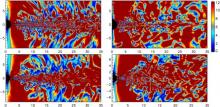
Abstract
We explore the parameter dependence of inner disk stress in black hole accretion by contrasting the results of a number of simulations, all employing 3-d general relativistic MHD in a Schwarzschild spacetime. Five of these simulations were performed with the intrinsically conservative code HARM3D, which allows careful regulation of the disk aspect ratio, H/R; our simulations span a range in H/R from 0.06 to 0.17. We contrast these simulations with two previously reported simulations in a Schwarzschild spacetime in order to investigate possible dependence of the inner disk stress on magnetic topology. In all cases, much care was devoted to technical issues: ensuring adequate resolution and azimuthal extent, and averaging only over those time-periods when the accretion flow is in approximate inflow equilibrium. We find that the time-averaged radial-dependence of fluid-frame electromagnetic stress is almost completely independent of both disk thickness and poloidal magnetic topology. It rises smoothly inward at all radii (exhibiting no feature associated with the ISCO) until just outside the event horizon, where the stress plummets to zero. Reynolds stress can also be significant near the ISCO and in the plunging region; the magnitude of this stress, however, depends on both disk thickness and magnetic topology. The two stresses combine to make the net angular momentum accreted per unit rest-mass 7--15\% less than the angular momentum of the ISCO.